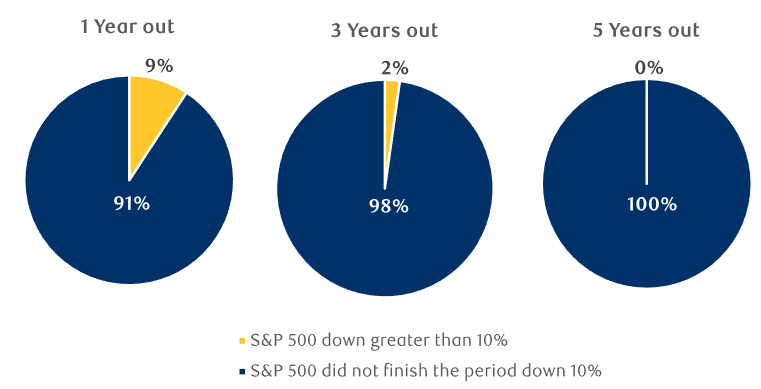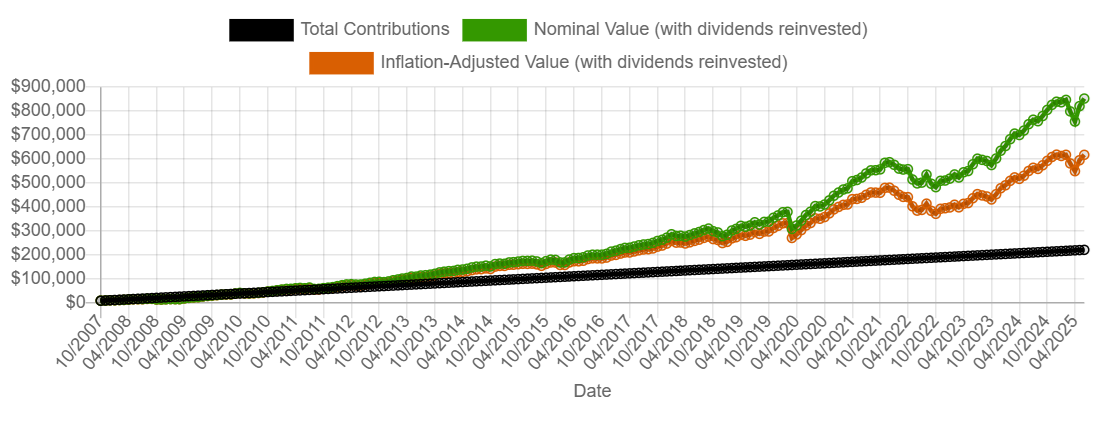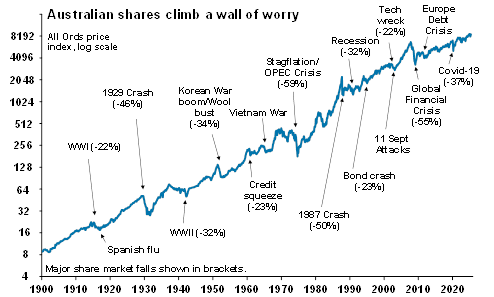The market’s at a record high – and that’s a terrible time to panic
Earlier this week, I joined my local Financial Independence Retire Early (FIRE) group for our monthly catch-up to talk all things money. The conversation started off light - until someone expressed a view that split the room:
“I don’t know about you, but with the S&P 500 at all-time highs, I'm not putting any more money in stocks."
It wasn’t said in panic, but it carried the tone of someone who’d been burned before - maybe during the GFC, maybe in 2022.
For those of us investing regularly through dollar-cost averaging (DCA) — committing a fixed amount at set intervals — it raised a key question: Does it really make sense to pause or reduce contributions, or cash out when markets hit all-time highs?
The bear case
For some investors, record highs feel less like a milestone and more like a warning sign. The logic is straightforward: markets have surged, valuations are stretched, and the downside risk is growing.
They point to inflated price-to-earnings ratios, a rally driven largely by a handful of mega-cap tech names, and lingering macro risks. Trade tensions are ongoing. Inflation isn’t fully tamed. The Federal Reserve and Reserve Bank of Australia have, on balance, been hawkish.
Plus, psychologically, it's simply scary to put money in the market when the index is in uncharted territory.
The bull case
The bulls - I am one of them - see it differently. All-time highs aren’t red flags - they’re part of the rhythm of long-term investing. If corporate earnings are growing and the economy is expanding, then markets should be hitting new highs over time.
What’s happening today isn’t just speculative froth - it’s being underpinned by genuine economic drivers: strong corporate earnings, a booming AI investment cycle, and a surprisingly resilient global economy. Just this week, the U.S. reported a robust annual gross domestic product (GDP) growth rate of 3%.
Meanwhile, Microsoft (NASDAQ: MSFT) and Meta (NASDAQ: META) smashed earnings expectations, sending their shares soaring, a clear stamp of approval from investors eager to see returns on their massive AI bets.
What history shows
The data tells a pretty compelling story.
According to Schroders’ Head of Research Duncan Lamont, markets are at all-time highs roughly 31% of the time. And on average, real returns following a record high have exceeded 10%. Lamont’s analysis also shows how destructive it could be for investors who choose to cash out each time the index peaks.
Furthermore, analysis by RBC Asset Management shows that major corrections — declines of more than 10% — occurred just 9% of the time one year after an S&P 500 all-time high, and became even less frequent over longer timeframes.

Put in a different way, imagine you invested $10,000 in the S&P 500 at its 2007 peak of 1,565 and added $1,000 every month after that. By the end of 2008, you'd be staring at a painful drawdown; a $26,000 investment would have fallen to around $16,000.
But by staying the course, you’d have seen the index:
- Recover in 2013
- Crack 2,000 in 2014
- Hit 3,000 in 2019
- Then 4,000 in 2021, 5,000 in 2024, and now 6,000 in 2025
If you’d tapped out in 2013, you would’ve needed to wait seven years and time the COVID crash perfectly to re-enter at extremely attractive valuations, but even then, you'd be buying at a higher price than where you exited and missed the dividends along the way.
And if you decided to cut contributions along the way simply because markets were "too high" your returns would be lower. Indeed, during the past decade, 2022 was the only year when the S&P 500 didn't set a single record high.
By sticking with the plan, you would have contributed $222,000 over time and would now be sitting on a portfolio worth just over $850,000. That’s an annualised return of around 13%, despite starting at the worst possible time.

Of course, past performance doesn't guarantee future results, and a market correction is always possible. But that's the strength of a dollar-cost averaging strategy - it smooths out your entry points by buying through the highs, lows, and everything in between. And as AMP’s Shane Oliver often reminds us, markets have a long history of climbing the ‘wall of worry’.
%20(1).png)
Focus on a good portfolio
Rather than halt contributions altogether, the bigger consideration is whether your portfolio still reflects your goals, time horizon, and risk tolerance. If you're investing for the next 20 or 30 years, does it really make sense to let short-term market movements dictate your moves?
As Warren Buffett once said:
"If you aren’t willing to own a stock for 10 years, don’t even think about owning it for 10 minutes."
That said, not all caution is irrational.
A raging bull market can stir up excitement - and not always the rational kind. Some investors are falling into the trap of massively overweighting tech or digital assets like Bitcoin, and chasing meme stocks like Krispy Kreme (NASDAQ: DNUT), without fully appreciating the volatility these exposures can bring to a portfolio.
Personally, I believe tech is impossible to ignore. AI is a genuine productivity revolution - it’s everywhere, and it’s consistently driving strong results for giants like Microsoft, Meta, and NVIDIA (NASDAQ: NVDA). Yes, P/Es are exploding. But so are profits and free cash flows.
Still, tech isn’t the whole picture.
Investors who overlook value and income do so at their own peril. Sectors like A-REITs, the ASX 200, and even corporate bonds are offering solid yields without the eye-watering valuations, and the value trade has worked well so far this year, underscoring the benefits of diversification across multiple strategies.
It's business as usual
In the end, all-time highs may feel uncomfortable. But based on the data, they aren’t necessarily a red flag. And one of my FIRE group’s more seasoned voices reminded us:
“We all work, we all contribute regularly to super or pension funds. That capital is mandated to be invested in growth assets. It doesn’t sit in cash waiting for a correction.”
And with that, the bears retreated back to the woods.
1 topic

